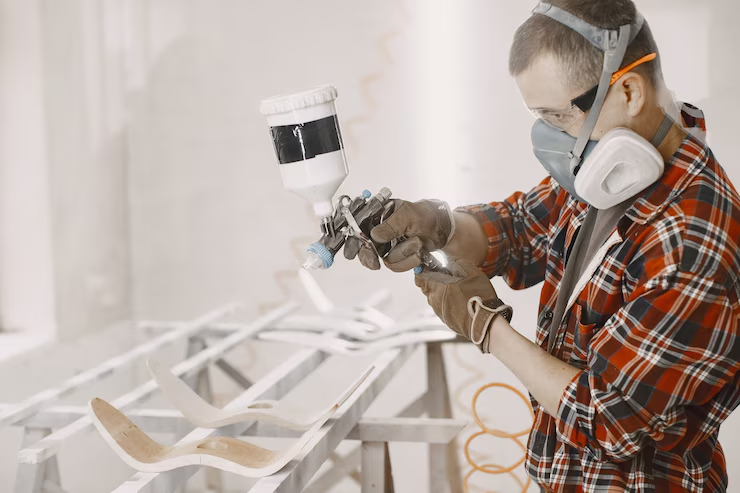How to Prep Walls for Painting
- Staff Desk
- May 14
- 4 min read

When walls are not properly prepared before painting, the consequences can be quite noticeable. Uneven paint coverage often results in a blotchy appearance, where some areas appear lighter or darker than others. Additionally, poor preparation can lead to peeling or flaking paint, particularly in areas with existing damage or dirt. These issues not only detract from the appearance but can also necessitate costly and time-consuming repairs down the line.
Benefits of Proper Wall Preparation
On the flip side, dedicating time to wall preparation yields a host of benefits. Well-prepared walls allow the paint to adhere more effectively, resulting in a smooth, even finish that enhances the room’s aesthetics. This adherence also contributes to the durability of the paint job, reducing the frequency of touch-ups or repainting. Furthermore, a well-prepared surface can better withstand environmental factors like humidity and temperature changes, maintaining its appearance over time.
Long-Term Cost Savings
Investing in proper wall preparation can also be a cost-effective strategy. While it may require additional time and materials upfront, the longevity and durability of a well-done paint job can lead to significant savings. By avoiding frequent repainting and repairs, homeowners can allocate their resources to other home improvement projects. Thus, preparation is not merely a step in painting but a smart financial decision.
Step 1: Gather Your Supplies

Essential Tools and Materials
To embark on your painting journey, equipping yourself with the right tools is essential. Drop cloths or plastic sheeting are vital to protect your floors and furniture from paint splatters and dust. Painter’s tape is indispensable for masking areas that should remain unpainted, such as trim and windows. A putty knife is necessary for applying spackle or joint compound to repair wall imperfections.
Choosing the Right Sandpaper
Sandpaper plays a crucial role in wall preparation, and selecting the appropriate grit is important. For most walls, a fine-grit sandpaper, such as 120 to 150 grit, is ideal for smoothing surfaces without causing damage. A sanding block can also be useful for achieving an even sanding pressure. By ensuring you have the right sandpaper, you can effectively prepare your walls for primer and paint.
Preparing Your Cleaning Solutions
Cleaning solutions are a cornerstone of wall preparation, and choosing the right one depends on the condition of your walls. A mild detergent mixed with water is suitable for general cleaning tasks, effectively removing dust and light grime. For more stubborn stains or greasy residues, trisodium phosphate (TSP) is a powerful alternative. By preparing these solutions ahead of time, you can streamline the cleaning process.
Step 2: Protect the Area

Setting Up Drop Cloths and Plastic Sheeting
Begin your preparation by laying down drop cloths or plastic sheeting to cover the floor and any furniture that cannot be moved. This step is crucial to safeguarding your belongings from paint splashes and dust accumulation. Ensure that the cloths are securely positioned to prevent any tripping hazards during the painting process.
Utilizing Painter's Tape Effectively
Painter's tape is an essential tool for creating clean, professional lines. Apply it carefully along the edges of trim, windows, and baseboards to prevent accidental painting. For best results, press the tape firmly to ensure a tight seal, which will help prevent paint from seeping underneath and creating unsightly smudges.
Organizing Your Workspace
Creating an organized workspace is vital for a smooth painting process. Arrange your tools and materials in a manner that allows easy access, reducing the need for constant searching. A well-organized space minimizes disruptions and helps maintain focus, enabling you to complete the preparation efficiently and effectively.
Step 3: Inspect the Walls

Identifying Wall Imperfections
Careful inspection of the walls is a critical step in the preparation process. Examine the surface for common imperfections such as cracks, holes, and peeling paint. Mark these areas with a pencil or tape so that you can easily locate them during the repair process. This proactive approach ensures no defects are overlooked.
Assessing the Need for Repairs
Once you've identified imperfections, evaluate the extent of the damage. Determine whether minor touch-ups will suffice or if more extensive repairs are necessary. For larger cracks or structural issues, consider consulting a professional to ensure the integrity of your walls before proceeding with painting.
Documenting Problem Areas
Keeping a record of the imperfections identified can be helpful, especially in larger spaces. Create a simple diagram of the room, noting the location and type of each defect. This documentation serves as a reference point during repairs, ensuring that all issues are addressed systematically and thoroughly.
Step 4: Clean the Walls

Dust and Dirt Removal
Dust and dirt can significantly impact paint adhesion, making their removal a priority. Start by using a dry cloth or duster to wipe down the walls, eliminating loose particles. This step is essential for ensuring the cleaning solution can effectively penetrate and clean the surface.
Applying Cleaning Solutions
With the surface dusted, apply your chosen cleaning solution using a sponge or cloth. Work in small sections, applying the solution and gently scrubbing the wall to remove grease and grime. For heavily soiled areas, allow the solution to sit briefly before wiping it clean, ensuring thorough removal of contaminants.
Rinsing and Drying the Walls
After cleaning, rinse the walls with a cloth dampened in clean water to remove any residual cleaning solution. It's important to ensure that no soap or TSP residue remains, as these can interfere with paint adhesion. Allow the walls to dry completely, which might take several hours, depending on the room's humidity and ventilation.
Conclusion
Proper preparation walls for painting is essential to achieving a professional-looking finish. By following these steps, you'll create a smooth, clean surface that's ready for a fresh coat of paint. Remember, taking the time to prepare the walls will pay off in the long run, resulting in a beautiful, long-lasting paint job. Happy painting!



Comments